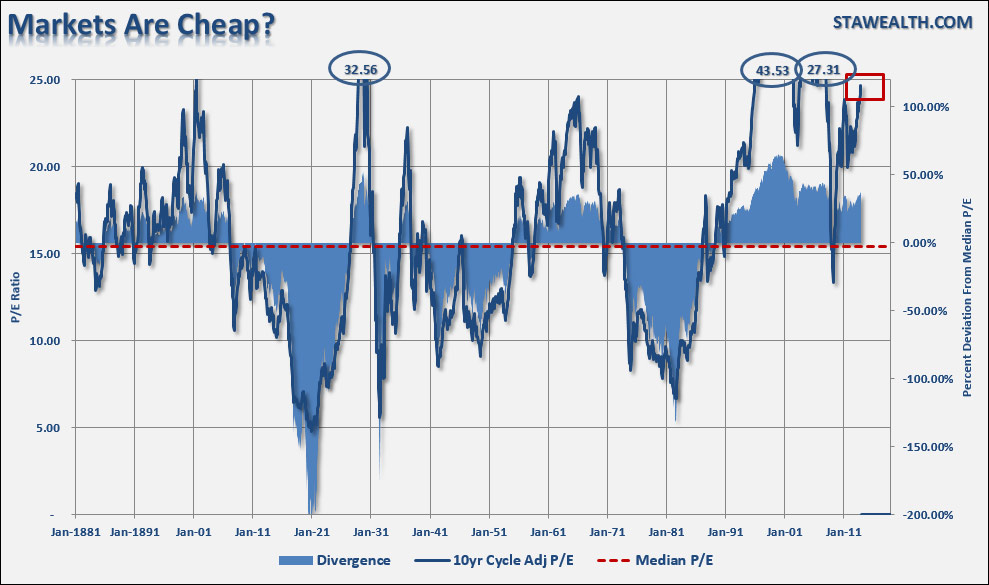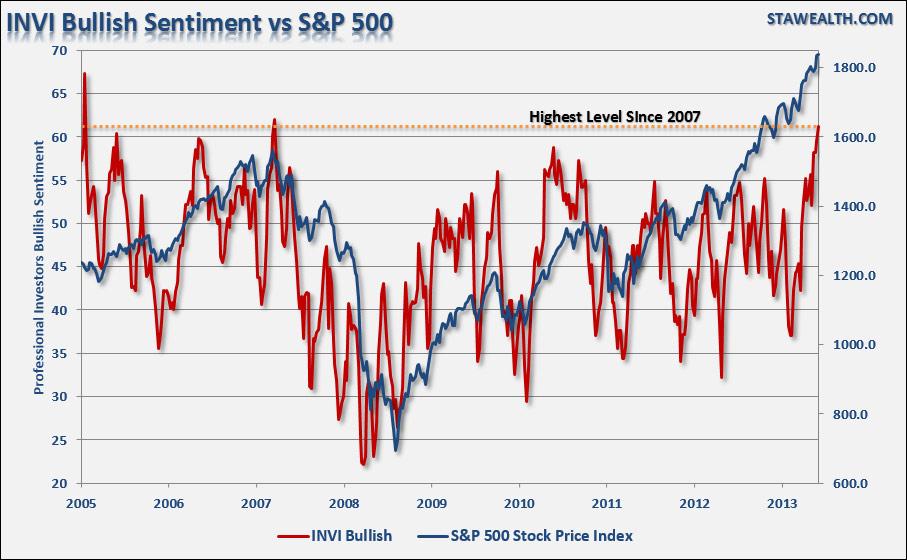There have been a litany of articles written recently discussing how the stock market is set for a continued bull rally. The are some primary points that are common threads among each of these articles which are: 1) interest rates are low, 2) corporate profitability is high, and; 3) the Fed's monetary programs continue to put a floor under stocks. The problem is that while I do not disagree with any of those points - they are all artificially influenced by outside factors. Interest rates are low because of the Federal Reserve's actions, corporate profitability is high due to accounting rule changes following the financial crisis and the Fed's liquidity program artificially inflates stock prices.
However, while the promise of a continued bull market is very enticing it is important to remember, as investors, that we have only one job: "Buy Low/Sell High." It is a simple rule that is more often than not forgotten as "greed" replaces "logic." However, it is also that simple emotion of greed that tends to lead to devastating losses. Therefore, if your portfolio, and ultimately your retirement, is dependent upon the thesis of a continued bull market you should at least consider the following charts.
It is often stated that valuations are still cheap. The chart below shows Dr. Robert Shiller's cyclically adjusted P/E ratio. The problem is that current valuations only appear cheap when compared to the peak in 2000. In order to put valuations into perspective I have capped P/E's at 25x trailing earnings as this has been the level where secular bull markets have previously ended. I have noted the peak valuations in periods that have exceeded that level.
The next chart is Tobin's Q Ratio. James Tobin of Yale University, Nobel laureate in economics, hypothesized that the combined market value of all the companies on the stock market should be about equal to their replacement costs. The Q ratio is calculated as the market value of a company divided by the replacement value of the firm's assets. With the exception of the "tech bubble" we are near the peak of every major bull market in history.
One argument that I hear made consistently is that retail investors are just now beginning to jump into the market. The chart below shows the percentage of stocks, bonds and cash owned by individual investors according to the American Association of Individual Investor's survey. As you can see, equity ownership and near record low levels of cash suggest that the individual investor is "all in."
Of course, with investors fully committed to stocks it is not surprising to see margin debt as a percentage of the S&P 500 at record levels also. It is important to notice that sharp spikes in this ratio have always coincided with market corrections of which some have been much worse than others.
Bob Farrell's rule #9 basically states that when everyone agrees; something else is bound to happen. The next two charts show the level of "bullishness" of both individual investors (AAII Survey) and professional money managers (INVI Survey). Surprisingly, professional money managers are more exuberant than individuals. It is interesting to note that the 8-week moving average of bullish sentiment for individuals has declined prior to the eventual peak in the market.
As I stated above - professional investors are just plain "giddy" about the market.
Lastly, an important chart I have shown previously, the deviation of the S&P 500 and the Wilshire 5000 from their respective 36-month moving average is at levels that have only been seen at four other periods previously.
As a money manager, I am currently long the stock market. I must be or I potentially suffer career risk. However, my job as an advisor is not only to make money for my clients, but also to preserve their gains, and investment capital, as much as possible. Understanding the bullish arguments is surely important but the risk to investors is not a continued rise but the eventual reversion that will occur. Unfortunately, since most individuals only consider the "bull case," as it creates confirmation bias for their "greed" emotion, they never see the "train coming."
Hopefully, these charts will give you some food for thought. Remember, every professional poker player knows how to spot a "pigeon at the table." Make sure it isn't you.












